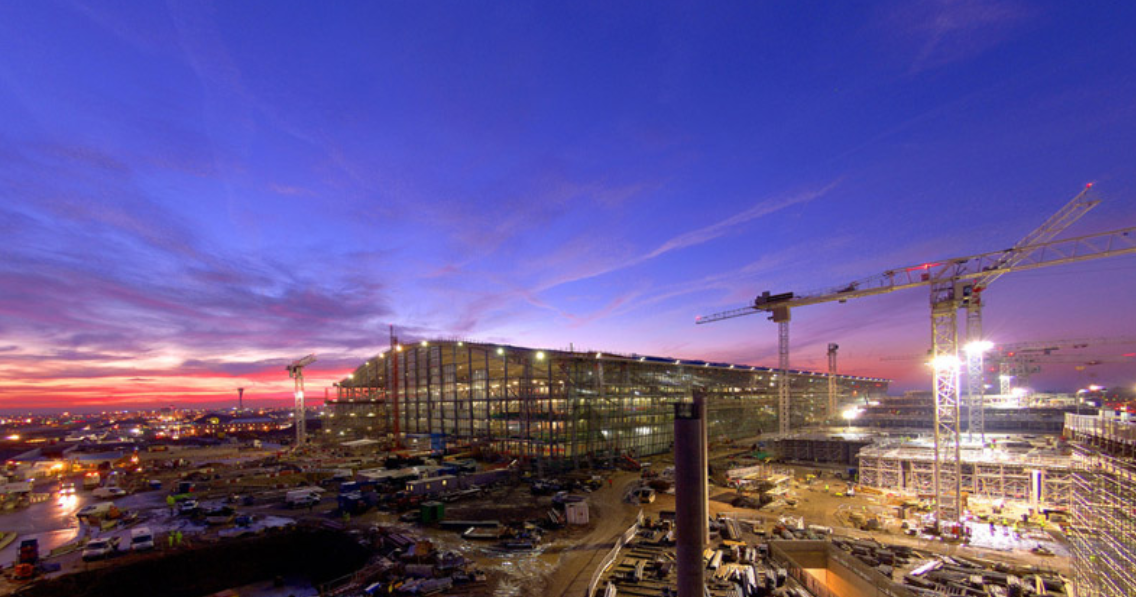Tackling the productivity challenge

|
| Construction work at Heathrow |
This article was originally published on 31 January 2020 by the Institution of Civil Engineers following a roundtable with industry leaders. It was written by Joseph Marner, MEng (Hons) GMICE, Engineer/President's Future Leader.
Contents |
[edit] Introduction
In general terms, productivity is the amount of output produced per unit of input, so it’s an indicator of efficiency. However, monitoring, measuring and increasing productivity in practical terms is not so simple.
[edit] Why worry about productivity?
In 2018, the UK construction industry generated £117bn of economic output which represented 6% of the UK's total GDP. By sector, 'infrastructure' orders were worth £11.5bn and 'commercial' orders valued at £15.2 bn. These numbers alone demonstrate the economic scale of the built environment industry. It’s clear to see that when we talk about infrastructure productivity the stakes are high. The problem, though, is that UK construction productivity lags behind most other major sectors (as measured by the Office of National Statistics). Looking outwards, the UK economy as a whole is less productive than all but one of the other G7 nations. So, there are improvements to be had. But if we don’t interrogate the problem then we can’t fix it.
[edit] What's stopping us from increasing productivity now?
You could increase productivity by making many incremental improvements. Small steps can only get you so far, though. It’s like being half-way up a mountain, trying to get to the highest point in the mountain range. You'll eventually get to the top of your mountain by taking many small steps towards higher ground. But if your goal is to get to the highest point in the whole range, it's likely that you'll need to get onto a different mountain. This holds true for productivity.
The consensus among the industry leaders present at the ICE roundtable was that we won’t achieve the productivity increases we’re aiming for if we continue to rely on incremental improvements. What we need is a revolution in how we do things - we need to get onto a higher mountain. This is difficult in an industry as large and as complex as ours, and where the profit margins for businesses are so tight.
From the experiences shared at the roundtable, current business models don't encourage proactive steps to improve productivity. It was pointed out that under current practices, if you found a way to work twice as fast, you'd likely only be paid half as much, and few people disagreed that this is typical. Ultimately this discourages organisations from improving productivity in favour of maximising their own revenue.
The significant upfront capital investment required to develop modern methods of construction was another concern shared by many in the room. Very few organisations are currently willing - or able - to put the cash required into research and development, particularly in the context of tight margins and fierce competition. There’s not yet confidence that innovative approaches will be widely adopted.
[edit] Isn't off-site construction the answer?
Design for Manufacture and Assembly (DfMA) is a construction approach whereby as much as possible is formed of standard components built offsite in a factory setting. The parts are then assembled on site. It’s prefabrication on a large, standardised scale.
Some in the industry believe that productivity could be increased three-fold or more by using a DfMA approach. Several first-hand examples were offered up at the roundtable to support this claim. And, we might be more ready for this than you think. It wouldn't be too difficult to take designs we already have and incorporate them into a repository of standard components over the course of the first, trailblazing projects.
There’s no need to perfect a catalogue of components before we start. However, plenty of concerns about the challenges to such an approach were raised. Firstly, relying on a small set of components could be seen as anti-competitive, which presents a regulatory hurdle. There's also the question of initial investment - someone will still have to invest in the offsite production facilities initially. Issues of liability under new arrangements and ownership of any new business models also needs to be better understood. And perhaps most importantly, designers and constructors will need to embrace a radical shift in thinking in order to make the concept successful. The human aspect of the problem may be the most difficult to overcome.
[edit] So, what do we need to do to improve productivity?
Good leadership is crucial. Any move to a new way of delivering infrastructure projects - whether that be DfMA or another approach - needs a clear champion.
There was broad agreement that funders and clients are in the best position to take up this role. Funders can provide confidence that the pipeline of infrastructure projects will be sustained so that the full potential of businesses’ commitments to new methods can be realised. Clients then need to drive the changes in approach and methods.
The right questions need to be asked at tender stage, and ways to increase productivity need to be incentivised. New approaches need to be embedded from the very beginning. Everyone agreed that consistency – in every sense – is also key. We need to be consistent in how we define productivity and measure improvements.
Our methods and the outputs we produce need to be compatible across industry sectors, geographies and clients. And we need to be consistent in approach across all projects. What was clear to me, though, is that achieving even small percentage increases in productivity will take massive effort across our industry, at all levels. I look forward to seeing and being part of whatever new approaches are adopted.
This article was originally published on the infrastructure blog on 31 January 2020 by the Institution of Civil Engineers following a roundtable with industry leaders. It was written by Joseph Marner, MEng (Hons) GMICE, Engineer/President's Future Leader.
--Institution of Civil Engineers
[edit] Related articles on Designing Buildings Wiki
Featured articles and news
RTPI leader to become new CIOB Chief Executive Officer
Dr Victoria Hills MRTPI, FICE to take over after Caroline Gumble’s departure.
Social and affordable housing, a long term plan for delivery
The “Delivering a Decade of Renewal for Social and Affordable Housing” strategy sets out future path.
A change to adoptive architecture
Effects of global weather warming on architectural detailing, material choice and human interaction.
The proposed publicly owned and backed subsidiary of Homes England, to facilitate new homes.
How big is the problem and what can we do to mitigate the effects?
Overheating guidance and tools for building designers
A number of cool guides to help with the heat.
The UK's Modern Industrial Strategy: A 10 year plan
Previous consultation criticism, current key elements and general support with some persisting reservations.
Building Safety Regulator reforms
New roles, new staff and a new fast track service pave the way for a single construction regulator.
Architectural Technologist CPDs and Communications
CIAT CPD… and how you can do it!
Cooling centres and cool spaces
Managing extreme heat in cities by directing the public to places for heat stress relief and water sources.
Winter gardens: A brief history and warm variations
Extending the season with glass in different forms and terms.
Restoring Great Yarmouth's Winter Gardens
Transforming one of the least sustainable constructions imaginable.
Construction Skills Mission Board launch sector drive
Newly formed government and industry collaboration set strategy for recruiting an additional 100,000 construction workers a year.
New Architects Code comes into effect in September 2025
ARB Architects Code of Conduct and Practice available with ongoing consultation regarding guidance.
Welsh Skills Body (Medr) launches ambitious plan
The new skills body brings together funding and regulation of tertiary education and research for the devolved nation.
Paul Gandy FCIOB announced as next CIOB President
Former Tilbury Douglas CEO takes helm.
UK Infrastructure: A 10 Year Strategy. In brief with reactions
With the National Infrastructure and Service Transformation Authority (NISTA).























